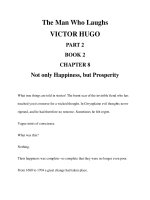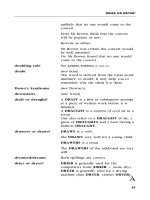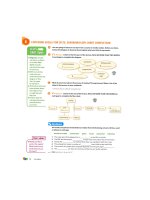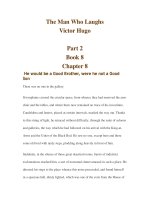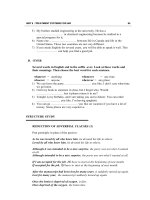Oganization struture questions 8 potx
Bạn đang xem bản rút gọn của tài liệu. Xem và tải ngay bản đầy đủ của tài liệu tại đây (73.93 KB, 6 trang )
48. c. The difference between 105 and 99 is 6 degrees.
Application of the ice pack plus a “resting”
period of 5 minutes before reapplication means
that the temperature is lowered by half a degree
every six minutes, or 1 degree every 12 min-
utes; 6 degrees times 12 minutes per degree
equals 72 minutes, or 1 hour and 12 minutes.
Section 3: Writing (Part A—
Multiple-Choice)
1. c. Middle Ages is a proper noun and should be
capitalized.
2. c. The objective pronoun her is misused in Part 1
as a subject pronoun; it needs to be replaced
with the pronoun she.
3. a. Quotation marks need to be inserted before the
quotation is resumed after the interrupting
phrase, the brochure informed her.
4. b. Part 1 states that guidelines were established,
and Part 4 states specifically what one of the
guidelines was, so Part 4 should follow Part 1.
Also the information in Part 2 follows from the
information in Part 4: Part 4 names roadblocks
as a type of guideline; Part 2 contains specific
information about roadblocks. So Part 2 should
be moved to come after Part 4.
5. d. In Part 8, the pronouns he or she need to be
changed to they to agree in number and person
with the antecedent officers.
6. a. The context requires a word meaning to add
something to complete a thing; choice a, sup-
plement, is the only word or phrase with that
meaning.
7. c. To correctly divide is a split infinitive. The infini-
tive is to divide. Choices a, b, and d do not make
this kind of error.
8. a. The context requires a verb that means to extend
beyond, not to come before. The words in the
other choices do not have this meaning.
9. a. Part 2 in the only interrogatory sentence in the
passage. Since it asks a question, it needs a ques-
tion mark as punctuation.
10. b. The main idea of this paragraph is that, while
genius has a recognizable pattern, the patterns
are extraordinary. Choice b directly states that
the patterns have the eerie quality of the fated.
11. c. The possessive Mozart’s is required before the
gerund composing.
12. a. Part 4 contains an error in pronoun/antecedent
agreement; the pronoun they must be changed
to it
in order to agree in number and person
with its antecedent, regularity.
13. d. Part 6 is a statement about the effect of the play
in theater history in general; however, this state-
ment is placed in the midst of a description of
the reception of the opening of the play. The
paragraph ends with a statement about the
play’s effect on theater history, so Part 6 should
either be moved to the end of the paragraph or
removed. Since there is no choice to move Part
6 to the end of the paragraph, choice d is the
correct answer.
14. c. The names of works that can be published on
their own should be italicized, even if only part
of the title (in this case Godot) is used to desig-
nate the work; therefore choice b is incorrect.
Choice a is incorrect because Mr. Godot names
a character, not the play. Choice d is incorrect
because the titles of newspapers must be itali-
cized.
15. a. The comma in Part 5 separates the subject,
critics and playgoers, from its verb, greeted.
16. b. Inserting a comma in Part 2, after the word
opening, separates the introductory clause from
the rest of the sentence. The sentences in choices
a, c, and d are correct as they are written.
17. d. The two independent clauses in Part 2 need a
conjunction in order for the sentence to be
grammatically correct. Choices a, b, and c are
– THEA PRACTICE EXAM 3–
275
incorrect because those sentences are correctly
written.
18. c. Part 8 should come before Part 7. Part 7 com-
ments on this final trait, but Part 8 details
another trait. Logically, all the characteristics
should be mentioned before commenting on
the final one.
19. a. The context requires a noun that defines aware-
ness of the moral or ethical side of one’s con-
duct; the word conscience has this meaning. The
words in the other choices do not have this
meaning.
20. b. The sentence is written in present tense, so the
present tense of believe is required.
21. d. In Part 6, the modifier finally is misplaced. It
would be better placed at the beginning of the
sentence.
22. c. The word the is necessary before the singular
wheelchair tie-down system.
23. a. A semicolon should separate two complete sen-
tences (independent clauses); the second half
of Part 6 is not a complete sentence but a restate-
ment of a portion of the first half. This makes a
colon appropriate.
24. c. The pronoun is one of the subjects of the sen-
tence, and so it should be changed from the
object form him to the subject form he.
25. a. The tone of this paragraph is formal and spe-
cific; it also uses professional jargon—for
instance, in referring to the parts of a house
with which firefighters should be familiar.
Choice c is correct because the phrase just fine is
too colloquial and informal for the tone of the
passage.
26. d. The semicolon after fires in Part 3 creates a sen-
tence fragment, because the phrase before the
semicolon is not an independent clause.
27. a. The comma is needed after process to set off the
interruptive phrase known as overhaul.
28. d. Since the sentence states that the system is
designed to give, then it needs to ensure as well.
Choices a, b, and c are correct as written.
29. c. The pronoun his should be replaced with their
in order to agree with federal employers.There
are no errors in pronoun agreement in choices
a, b,or d.
30. c. The paragraphs are related in that they both
talk about the physical effects or extreme heat on
people and the treatment of these conditions.
Each paragraph’s main subject is a different con-
dition suffered because of extreme heat. The
second paragraph begins by mentioning that
heat stroke, the subject of the paragraph, is
much more serious than the condition men-
tioned above, heat exhaustion. Choice c
best
aids the transition by ending the first paragraph
with an explanation of the most serious effects
of heat exhaustion, thereby paving the way for
the contrasting description of the far more seri-
ous condition, heat stroke.
31. d. The main idea of this paragraph is a description
of the symptoms and treatment of heat stroke.
The information in Part 7 about the most com-
mon victims of heat stroke is least relevant to the
topic of the paragraph.
32. b. Part 1 is a sentence fragment; it contains no
main verb.
33. a. Choice a is written in the tone and style reflected
in the passage. Choices b, c, and d are awkward
versions of the same details.
34. d. The verb needs to be singular to agree with
Theodore Roosevelt. Choices a, b, and c are incor-
rect because they introduce a shift in tense.
35. d. Commas are used to separate city from country.
Choices a, b, and c would make the sentences
grammatically incorrect.
36. b. Titles of books are always underlined or itali-
cized. Short stories (choice a) are punctuated
with quotation marks. Author’s names (choice
c) are not italicized. Copyrights do not need
italics (choice d).
37. c. This choice adds the subject he in the second
sentence, eliminating the dangling modifier
– THEA PRACTICE EXAM 3–
276
walking down the street. Otherwise, the sentence
reads as if the leaves are walking down the street.
38. b. This paragraph’s purpose is descriptive; it
describes the classroom and the corridor outside
it. Choice b is correct because the information
in the sentence adds to the description of the
corridor.
39. d. Part 6 is a dependent clause with no independ-
ent clause to attach itself to; therefore, it is a
sentence fragment.
40. d. The word wreaked should be replaced in this
context by its homonym, reeked.
Section 3: Writing (Part B—
Writing Sample)
Following are the criteria for scoring THEA essays.
A “4” essay is a well-formed writing sample that
addresses the assigned topic and conveys a unified mes-
sage to its audience. Additionally, it has the following
characteristics:
■
a clear purpose and focus
■
controlled development of a main idea
■
clear, concrete, and effective details supporting
the main idea
■
effective, error-free sentence structure
■
precise and careful word choice
■
mastery of mechanics such as punctuation and
spelling
A “3” essay is an adequate writing sample that
addresses the assigned topic and clearly attempts
to convey a message to its audience. Generally, it
has the following additional characteristics:
■
a clear focus and purpose
■
organization of ideas that may be vague, incom-
plete, or only partially effective
■
an attempt at development of supporting details,
which is only partly realized
■
word choice and language usage that are ade-
quate; but with minor errors in sentence struc-
ture, usage, and word choice
■
mechanical mistakes such as errors in spelling
and punctuation
A “2” essay is an incompletely formed writing
sample that lacks clear focus. It has the following addi-
tional characteristics:
■
main topic announced but focus on it is not
maintained
■
unclear purpose
■
use of some supporting detail but development
and organization unclear
■
sentences and paragraphs poorly structured
■
distracting errors in sentence structure
■
imprecise word usage
■
distracting mechanical mistakes such as errors in
spelling and punctuation
A “1” essay is an incompletely formed writing
sample that fails to convey a unified message. It has the
following additional characteristics:
■
attempt at addressing the topic, which fails
■
no clear main idea
■
language and style that are inappropriate to the
audience and purpose
■
attempt to present supporting detail which is
muddled and unclear
■
attempt at organization but failure to present a
clear sequence of ideas
■
ineffective sentences, very few of which are free of
error
■
imprecise word usage
■
many distracting mechanical mistakes, such as
errors in spelling and punctuation
– THEA PRACTICE EXAM 3–
277
A “U” essay is a writing sample that fails because
of one or more of the following:
■
failure to address the assigned topic
■
illegibility
■
written primarily in a language other than
English
■
length insufficient to score
A “B” essay is a writing sample left completely
blank (that is, the test-taker did not respond at all).
Following are examples of scored writing sam-
ples. (Note: There are some deliberate errors in all the
essays.)
Sample “4” essay
The best way for teachers to boost their students’ sci-
ence test scores is to stop worrying quite so much
about the scores and start being concerned about
making the students excited by science.
Before ever asking students to memorize facts,
the teacher should demonstrate a scientific process
or, better, teach the students how to experiment for
themselves, allowing them to apprehend the process
with their senses before trying to fix it in their intel-
lect. For example, the teacher might pass around an
ant farm in the class room and let the students
observe the little critters skittering behind the glass,
going about their complex, individual tasks, before
asking the student to read that ants have a rigid
social structure, just as people do. If possible, it
would be even better to take them on a field trip to
observe a real ant-hill or to see how other kinds of
real animals behave, say on a farm or in a zoo. The
teacher might allow the students to create a chemi-
cal reaction in a beaker asking them to memorize the
formula.
When I was small, I had first-hand experience
with this kind of teaching. My father built a tele-
scope (a painstaking project that should only be
taken on out of love because it is a very difficult,
intricate task). The telescope had a clock at its base
that kept it fixed on the moon or stars rather than
turning as the earth turns. When my father
switched off the clock, I remember watching
through the eyepiece, fascinated at how quickly the
stars drifted out of my field of vision—it took only
seconds—and even more fascinated to realize that
what I was seeing was us floating so swiftly through
space. He told me the magical names of the geo-
logical formations on the moon, such as the crater
called “The Sea of Tranquillity.” When I looked
through the lens, the pock-marked silvery disc of
the moon seemed as close as the hills behind our
suburban house.
After that, I became interested in the statistics
such as the rate of the rotation of the earth, the geo-
physical facts behind the making of the craters that
form the moon’s laughing face, in a way I never
would have if the facts had been the starting point of
a lecture.
This approach should be begun, not in high
school or college, but in grade school or even in
kindergarten. The facts are important, of course—
without them, we can have no real understanding.
But curiosity is as vital to learning as the ability to
memorize—perhaps more so. Because curiosity will
keep students learning long after they have passed
their final test in school.
Sample “3” essay
Science is important for many reasons, but espe-
cially because today’s world is based on technology.
If other countries get ahead of us in science the con-
sequences may be dire. So it is extremely important
for our students to excell.
The first and best way to teach science is to
make the student see the practical application of it.
For example, if the teacher is teaching botony, she
might explain the medical uses of plants. Or if
teaching physics, she might show a diagram of a
rocket ship. Field trips are a good idea, as well,
– THEA PRACTICE EXAM 3–
278
perhaps to a factory that makes dolls. The point is
to make it practical and interesting to boys and
girls alike.
When I was in high school I had a teacher
named Mr. Wiley who let us mix things in jars and
watch the results. Sometimes they were unexpected!
Such as a kind of mushroom we planted that was
poisonous and reminded us of the horror movies we
all loved in those days. Mr. Wiley made it interesting
in a personal way, so that it wasn’t just dry facts. And
he told us the practical uses, such as this particular
kind of mushroom is used in the making of certain
insect poison.
In this day and age it is important for all of us
to know something about science because it affects
all aspects of our lives, but for young people it is vital.
Their livelihoods—and even their lives—may
depend on that knowledge.
Sample “2” essay
Science is a necesary skill because it can effect each
one of us, such as a cure for disease. It is responsable
for TV, cars, and other items we take for granted. So
we all depend on it and need to learn it.
The best way to teach science is to have a good
textbook and also good equiptment in the class-
room. If the equiptment is poor there is no way they
are going to learn it, which is why the poorer schools
are behind the richer ones and also behind other
countries. Its the most important factor in the class-
room today.
Another way to teach science is through field
trips and vidio-tapes. There are many tapes in the
library and every school should have a good vidio
system. Also a good library is importent. And there
are many places to take the class that they would find
intresting.
When I was in school I thought science was
boring. I wish I had learned more about it because
I think it would make me understand the world of
technology. If we don’t understand technology we
are at it’s mercy, and it is something we rely on to get
us through our lives. Without science we would have
no technilogical advances. If other countries are
ahead of us it is our own fault for not putting science
as a priority.
Sample “1” essay
Science is importnant and we should teach it to our
students in the right way. A scientist coming in to
talk would be one way. Also experimints that the stu-
dents can do. The reason it is important, is other
countrys are ahead of us and we may have a war.
Then if there tecnoligy is better they will take us
over. So it is dangerous not to have students that
know alot about science.
If we teach our children to relay too much on
science and technoligy what will happen if it fails. If
the computers fail we are in serious trouble. Which
shows that science cant solve everything! There is
still no cure for cancer and our products cause polu-
tion. So science is important and our students
should learn but it isnt everything and they should
learn that they should study other things to.
If we teach science in the right way our coun-
try will be better off as well as our children when
they are caught up.
Scoring
Evaluate how you did on this practice exam by scoring
the three sections of the THEA—Reading, Mathemat-
ics, and Writing—separately. For the Reading section,
the Mathematics section, and the multiple-choice sub-
section of the Writing section, use the same scoring
method. First, find the number of questions you got
right in each section. Questions you skipped or got
wrong don’t count; just add up the number of correct
answers. Divide your number of correct answers by
the number of questions in that section to find your
percentage.
– THEA PRACTICE EXAM 3–
279
In addition, as mentioned in previous chapters,
you must receive a passing score on the writing sample
subsection of the Writing section of the THEA. Your
writing sample will be graded by two readers and their
combined score used to evaluate how you did. Your
score will be a combination of the two readers’ judg-
ments, somewhere between a possible high of 8 and a
low of 2. To see how you did on your essay for this third
and final practice exam, be sure to give it and the scor-
ing criteria to a teacher and ask him or her to score your
essay for you.
You have probably seen improvement between
your first practice exam score and this one; but if you
didn’t improve as much as you would like, following are
some options for you to consider:
■
If you scored below 60%, you should seriously
consider whether you are ready for the THEA at
this time. A good idea would be to take some
brush-up courses, either at a community college
nearby or through correspondence, in the areas
you feel less sure of. If you don’t have time for a
course, you might try private tutoring.
■
If your score is in the 60% to 70% range, you
need to work as hard as you can to improve your
skills. Reread and pay close attention to all the
information in Chapters 2, 4, 5, and 6 of this
book to improve your score.
■
If your score is between 70% and 80%, you could
still benefit from additional work by going back to
Chapters 4, 5, and 6 and by brushing up on your
reading comprehension and general math skills
before the exam.
■
If you scored above 80%, that’s great! This kind of
score should make you a success in the academic
program of your choice. Don’t lose your edge,
though; keep studying right up to the day before
the exam.
The key to success in almost any pursuit is to
prepare for all you are worth. By taking the practice
exams in this book, you have made yourself better pre-
pared than other people who may be taking the exam
with you. You have diagnosed where your strengths
and weaknesses lie and learned how to deal with the
various kinds of questions that will appear on the test.
Go into the exam with confidence, knowing that you
are ready and equipped to do your best.
– THEA PRACTICE EXAM 3–
280





